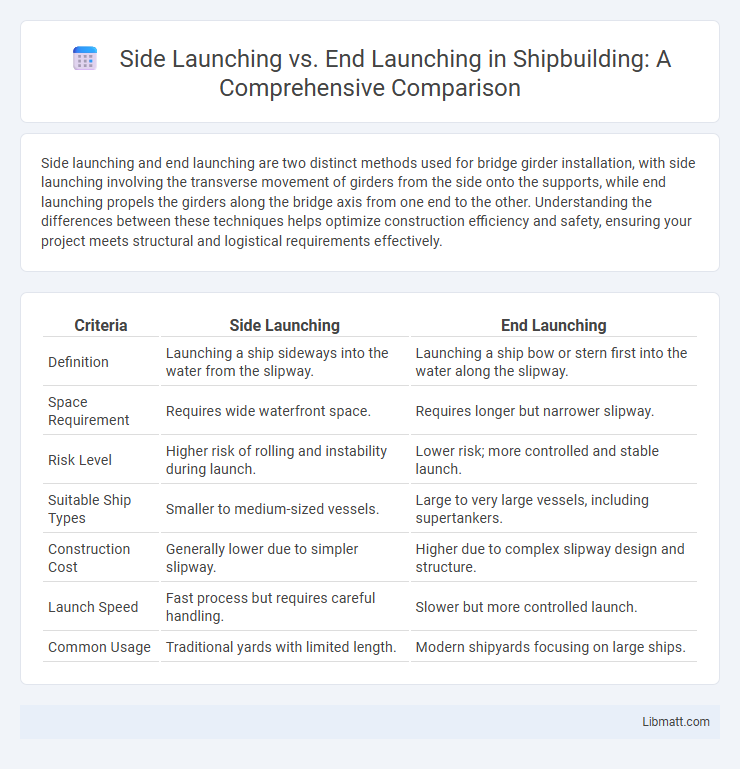Side launching and end launching are two distinct methods used for bridge girder installation, with side launching involving the transverse movement of girders from the side onto the supports, while end launching propels the girders along the bridge axis from one end to the other. Understanding the differences between these techniques helps optimize construction efficiency and safety, ensuring your project meets structural and logistical requirements effectively.
Table of Comparison
| Criteria | Side Launching | End Launching |
|---|---|---|
| Definition | Launching a ship sideways into the water from the slipway. | Launching a ship bow or stern first into the water along the slipway. |
| Space Requirement | Requires wide waterfront space. | Requires longer but narrower slipway. |
| Risk Level | Higher risk of rolling and instability during launch. | Lower risk; more controlled and stable launch. |
| Suitable Ship Types | Smaller to medium-sized vessels. | Large to very large vessels, including supertankers. |
| Construction Cost | Generally lower due to simpler slipway. | Higher due to complex slipway design and structure. |
| Launch Speed | Fast process but requires careful handling. | Slower but more controlled launch. |
| Common Usage | Traditional yards with limited length. | Modern shipyards focusing on large ships. |
Introduction to Ship Launching Methods
Side launching involves sliding the vessel sideways into the water from a slipway, suitable for narrow waterways and limited dock space, whereas end launching propels the ship stern-first along a ramp or slipway directly into the water, ideal for larger ships requiring controlled entry. Side launching is often faster and less costly but demands careful balancing to prevent capsizing, while end launching provides greater stability and is preferred for vessel dimensions exceeding the constraints of side launches. Both techniques are integral in shipyards, with selection criteria based on ship size, water depth, available infrastructure, and safety considerations.
What is Side Launching?
Side launching is a ship launching method where a vessel is constructed parallel to the shoreline or pier and then moved sideways into the water. This technique is often employed in shipyards with limited waterfront space, allowing efficient use of the available area without extending the slipway into the water. Side launching requires precise structural support and careful monitoring to prevent hull damage during the lateral transfer.
What is End Launching?
End launching is a method used for moving large bridge girders or structural beams by pushing them from one end using hydraulic jacks or launching equipment. This technique allows for precise placement and control when positioning heavy components over obstacles like rivers or roads. Understanding end launching helps you select the appropriate construction method based on site constraints and project requirements.
Key Differences Between Side and End Launching
Side launching involves launching a vessel or structure parallel to the shoreline, minimizing water entry impact and allowing controlled horizontal movement. End launching propels the vessel or structure perpendicular to the shoreline, often used for larger ships or structures requiring a straight, forward trajectory. Key differences include spatial requirements, impact forces on the hull, and suitability for different vessel sizes and environmental conditions.
Advantages of Side Launching
Side launching offers greater flexibility for vessel construction and repairs because it allows for easier access to the ship's hull and equipment compared to end launching. You benefit from reduced risk of structural damage since the ship enters the water more gently along its length, minimizing impact stress. This method also enables launching in confined waterways where traditional end launching may be impractical, enhancing operational efficiency.
Advantages of End Launching
End launching offers significant advantages such as improved safety by eliminating the need for workers to access hazardous side areas during pipeline installation. It allows for efficient handling of long pipe sections in confined spaces where side launching is impractical. The method also ensures better alignment and reduced pipe damage, leading to enhanced structural integrity and lower maintenance costs.
Challenges and Risks of Side Launching
Side launching of vessels poses significant challenges including limited maneuverability in confined waterways, increasing the risk of collisions and structural damage. The uneven distribution of forces during side launching elevates the likelihood of hull deformation and instability, potentially compromising vessel integrity. Furthermore, environmental factors such as strong currents and wind can exacerbate control difficulties, heightening safety hazards for both the ship and nearby personnel.
Challenges and Risks of End Launching
End launching poses significant challenges such as requiring precise alignment to avoid structural damage during insertion or extraction of the bridge girder. The risks include potential instability under load, increased susceptibility to lateral forces, and the need for specialized equipment to manage heavy components safely. You must ensure thorough risk assessments and strict adherence to engineering protocols to mitigate hazards associated with end launching operations.
Factors Influencing the Choice of Launching Method
The choice between side launching and end launching largely depends on factors such as the project site constraints, available waterway width, and structural design of the bridge. Side launching is preferred when limited longitudinal space exists, allowing the structure to be slid laterally into position, while end launching suits narrow waterways with sufficient approach length for incremental bridge advancement. Your selection must also consider the weight, length, and shape of the bridge segments, as well as the equipment and safety requirements inherent to each method.
Conclusion: Choosing the Optimal Ship Launching Method
Side launching offers a cost-effective solution for smaller vessels with limited dock space, while end launching provides enhanced control and safety for larger ships in deepwater conditions. The optimal ship launching method depends on vessel size, available infrastructure, and environmental factors such as water depth and tidal variations. Careful evaluation of these parameters ensures efficient, safe, and economically viable launching tailored to specific shipbuilding projects.
Side launching vs end launching Infographic

 libmatt.com
libmatt.com